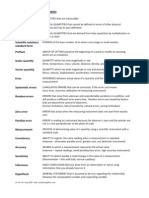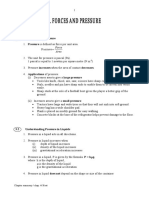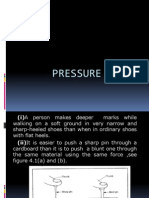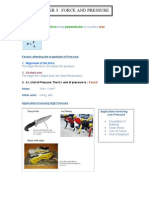Physics Form 4
Uploaded by
Woody CysPhysics Form 4
Uploaded by
Woody CysForm 4 Chapter 3: Forces and Pressure
3.1 Understanding Pressure
Pressure 1. Pressure is defined as a perpendicular force acting per unit area of a surface. 2. 3. The SI unit of pressure is Pascal (Pa). 1 Pa is equal to 1 Newton per meter square (N/m2) Factors that affect the pressure acting on a surface: a) Magnitude of the Force The larger the force, the higher the pressure b) Contact area The larger the contact area, the lower the pressure Examples of Application of Low Pressure Foundation of Building Snow shoes Tyre of tractor Feet of Elephant
Examples of Application of High Pressure a) Sharp Knife b) Ice Skate c) Sole of shoes with spike
a) b) c) d)
Examples: 1. The weight of a wooden block with dimensions as shown in the figure is 12N. Calculate the maximum pressure that the block exerts on the floor.
Solution: Maximum pressure happened when the contact area is the smallest, Area= 0.2 x 0.3 = 0.06 m2 Pressure= = 200 Pa.
3.2 Understanding Pressure in Liquids
Pressure in Liquids 1. Pressure in liquid is as a result of the weight of the liquid acting on the surface of any objects in the liquid. 2. Pressure of a liquid is directly proportional to : a) the depth, h b) the density of the liquid, ("rho") c) the gravitational field strength, g 3. Formulae: a) Pressure caused by a liquid b) Pressure in a liquid Patm = Atmospheric pressure, 1.01 x 105
CYS 1
Form 4 Chapter 3: Forces and Pressure
Deriving the Formula for Pressure in Liquid
*PRESSURE IN LIQUID DOES NOT DEPEND ON THE SURFACE AREA* Characteristic of Pressure in Liquid 1. The pressure of liquid increase with depth 2. The pressure of liquid acts in all direction. 3. The pressure of liquid does not depend on the area of its surface. 4. The pressure of liquid does not depend on the shape and size of the container. 5. The pressure of liquid at the same level in the same liquid are equal. U-Tube 1. Usually , a U-Tube is used to compare and measure density of liquids. 2. The density of the 2 liquids is related by the equation:
Application of Liquid Pressure 1. Dam 2. Submarine 3. Measuring Blood Pressure 4. Intravenous Transfusion 5. Water Tower
CYS
Form 4 Chapter 3: Forces and Pressure
3.3 Understanding Gas Pressure and Atmospheric Pressure
How Gas Pressure produced in a Closed Container? 1. Gas molecules inside the container are in constant and random motion. 2. As a result, the gas molecules collide on the inner wall of the container. 3. After colliding on the wall, the gas molecules bounce off, and the direction change creating a change of momentum to the molecules of the gas. 4. The change of momentum produces a force on the wall. 5. The force per unit area is the pressure on the wall.
Factors Affecting the Air or Gas Pressure 1. Pressure increases when the density of gas increases.
2. Pressure increases when the temperature increases (kinetic energy of the molecules increases)
Atmospheric Pressure 1. On the surface of the earth, there is a thick layer of gas called atmosphere. The atmosphere consists of various types of gas called the atmospheric gas. 2. The atmospheric gases collide on the surface of the earth and hence exert a pressure on the surface of the earth, called the atmospheric pressure. 3. The atmospheric pressure can be measured in the unit of atm, mmHg or Pa. The atmospheric pressure at sea level is taken to be 1 atm, which is approximately 760 mmHg or 101,000 Pa.
CYS
Form 4 Chapter 3: Forces and Pressure
Proof of Existence of Atmospheric Pressure The existence of the atmospheric pressure can be proved by the following experiments: Crushing can experiment Water cover with cardboard does not flow out Instrument used to Measure Atmospheric Pressure: Simple barometer Fortin barometer Aneroid barometer Simple Barometer
Unit Used to Measure Atmospheric Pressure 1. Pascal (Pa) 1Pa = 1 N/m2 2. Standard Atmospheric Pressure (atm) 1atm = 101,325 Pa 3. mmHg 1 atm = 760 mmHg = 76cmHg
CYS
Form 4 Chapter 3: Forces and Pressure
Characteristic of the Mercury Barometer
Applications of Atmospheric Pressure
CYS
Form 4 Chapter 3: Forces and Pressure
Instruments Used to Measure Gas Pressure The pressure of the gas in a container can be measured by using : 1. Manometer 2. Bourdon Gauge 3. Fortin Barometer 4. Aneroid Barometer Manometer Bourdon Gauge
3.4 Pascal's Principle
1. Pascal's Principle states that the pressure exerted on an enclosed liquid is transmitted equally throughout the liquid. 2. Pascal's principle is also known as the principle of the transmission of pressure in liquid. Experiment : When the plunger is pushed in, the water squirts equally from all the holes. This shows that the pressure applied to the plunger has been transmitted uniformly throughout the water.
Hydraulic System
Change of Oil Level in a Hydraulic System
A hydraulic system applies Pascal's principle in its working mechanism. It can be used as a force multiplier.
In the diagram to the left, when piston-X is pressed down, piston-Y will be push up. The change of the piston levels of the 2 pistons is given by the following equation.
CYS
Form 4 Chapter 3: Forces and Pressure
3.5 Archimedes' Principle
Archimedes' Principle Law of Flotation
1.
2.
Archimedes' Principle states that when a body is wholly or partially immersed in a fluid, it experiences an upthrust equal to the weight of the fluid displaced. Upthrust/Buoyant force is an upward force exerted by a fluid on an object immersed in it.
1.
2.
The principle of floatation states that when an object floats in a liquid the buoyant force/upthrust that acts on the object is equal to the weight of the object. If the weight of the object > upthrust, the object will sink into the fluid.
F =Upthrust/Buoyant Force
= Density of the liquid V = Volume of the displaced liquid g = Gravitational field strength *Revision Note: *
Examples of Law of Flotation:
CYS
Form 4 Chapter 3: Forces and Pressure
Applications of Archimedes' Principle 1. Submarine
A submarine floats in the sea because the buoyant force acting on the submarine is the same as the weight of the submarine.
When water enters the ballast tank of a submarine, the weight of the submarine becomes greater than the buoyant force. Thus, the submarine dives into the sea.
When the compressed air forces water out of the ballast tank, the weight of the submarine becomes less than the buoyant force. Thus, the submarine rises.
2. Hot Air Balloon
a. Hot air expand and large volume of air is displaced. b. Hot air lower density than the surrounding air. When buoyant force is greater than the weight of the balloon, the balloon start rising up. c. When the height increases, the density of air decreases. Thus, buoyant force is less. d. Balloon remain stationary in the air when buoyant force is equal to the weight of the balloon. 3. Ship
a. A ship, though very heavy, floats in the sea. This is because the volume of water displaced by the ship is sufficiently large to have a weight equal to the weight of the ship. b. Although the ship is constructed of metal, which has greater density than water, its shape is hollow so that the overall density of the ship is less than the sea water. c. A ship will submerge deeper in fresh water because the density of fresh water is less than seawater
CYS
Form 4 Chapter 3: Forces and Pressure
4. Hydrometer
a. Hydrometer is an instrument used to measure the relative density of liquids. b. The lead shots are placed in the bulb to weight it down and enable the hydrometer to float vertically in a liquid. c. Liquid of lower density, a greater volume of liquid must be displaced for the buoyant force to equal the weight of the hydrometer and so it sinks. d. Liquid density high = hydrometer float higher e. Liquid density low = hydrometer sinks lower f. The scale of the hydrometer stem can be calibrated to give reading for density in units of g/cm3.
3.6 Understanding Bernoulli's Principle
Bernoulli's Principle states that as the speed of a moving fluid (liquid or gas) increases, the pressure within the fluid decreases.
Examples of Bernoulli's Principle a. Air is blown across the top of the paper. b. The flow of air at high speed creates a region of low pressure across the top of the paper. c. The still air beneath the paper is at a higher pressure. d. Therefore a net upward force lifts the paper. a. Water flow faster in narrow tube than in wider tube. b. The pressure at B is the lowest because the water flow the fastest at B. Therefore the water level is the lowest at B.
CYS
Form 4 Chapter 3: Forces and Pressure
a. When air is blown through the tube, the narrow section B has a lower pressure. b. The external atmospheric pressure pushes the water in B to its highest level.
a. When the bunsen burner is connected to a gas supply, the gas flow at high velocity. b. Outside air is drawn in and mixes with the gas. c. Mixture of gas and air enables the gas to burn completely.
a. When a plane wing in the form of an aerofoil moves through air, the flow of air over the top has to travel faster to cover a longer distance and creates a region of low pressure. b. The flow of air below the wing is slower resulting in a region of higher pressure.
CYS
10
You might also like
- Roitt'S Essential Immunology 12Th Edition (All Mcqs With Answers)100% (9)Roitt'S Essential Immunology 12Th Edition (All Mcqs With Answers)100 pages
- Quantum Measurement and Control - Wiseman & Milburn100% (1)Quantum Measurement and Control - Wiseman & Milburn478 pages
- LS 25S Parts Manual Generation I Model PDF100% (2)LS 25S Parts Manual Generation I Model PDF76 pages
- Form 4 Additional Mathematics Chapter 6 Coordinate Geometry0% (1)Form 4 Additional Mathematics Chapter 6 Coordinate Geometry14 pages
- Modul Perfect Score SBP Physics SPM 2013 Question and Scheme100% (8)Modul Perfect Score SBP Physics SPM 2013 Question and Scheme299 pages
- Quick Revision Paper 3 Section B Physics SPMNo ratings yetQuick Revision Paper 3 Section B Physics SPM7 pages
- Understanding Pressure: Applications of Pressure in Everyday LivingNo ratings yetUnderstanding Pressure: Applications of Pressure in Everyday Living9 pages
- SPM PHYSICS SHORT NOTES CHAPTER 3 Forces and PressureNo ratings yetSPM PHYSICS SHORT NOTES CHAPTER 3 Forces and Pressure8 pages
- Pressure in Fluids and Atmospheric PressureNo ratings yetPressure in Fluids and Atmospheric Pressure4 pages
- 3.6 Bernoulli's Principle: Chapter 3 Forces and PressureNo ratings yet3.6 Bernoulli's Principle: Chapter 3 Forces and Pressure25 pages
- Chapter No. 4 Physics Pressure in Fluids and Atmospheric PressureNo ratings yetChapter No. 4 Physics Pressure in Fluids and Atmospheric Pressure12 pages
- 2408151108501820241pressure in Fluids and Atmospheric PressureNo ratings yet2408151108501820241pressure in Fluids and Atmospheric Pressure8 pages
- Pressure: Online Learning Resources For Malaysia StudentsNo ratings yetPressure: Online Learning Resources For Malaysia Students0 pages
- Chapter Four: Pressure: - Lesson Objectives - by The End of The Lesson, The Learner Should Able ToNo ratings yetChapter Four: Pressure: - Lesson Objectives - by The End of The Lesson, The Learner Should Able To48 pages
- 6.1 Kinetic Energy of Gases and Air PressureNo ratings yet6.1 Kinetic Energy of Gases and Air Pressure3 pages
- Outcome 1 Static Fluid Systems Tutorial 1 Hydrostatics PDFNo ratings yetOutcome 1 Static Fluid Systems Tutorial 1 Hydrostatics PDF20 pages
- Physics 1-Grade 10 Semester 2 Final Exam Revision Sheet 15.3 Pressure and DepthNo ratings yetPhysics 1-Grade 10 Semester 2 Final Exam Revision Sheet 15.3 Pressure and Depth3 pages
- PDF From Finite Sample to Asymptotic Methods in Statistics 1st Edition Pranab K. Sen download100% (1)PDF From Finite Sample to Asymptotic Methods in Statistics 1st Edition Pranab K. Sen download77 pages
- Complex Analysis - George Cain - Georgia Institute of TechnologyNo ratings yetComplex Analysis - George Cain - Georgia Institute of Technology115 pages
- Qorvo 5g Wireless Infrastructure Brochure PDFNo ratings yetQorvo 5g Wireless Infrastructure Brochure PDF4 pages
- Web Dynpro ABAP - OTR Text Translation ToolNo ratings yetWeb Dynpro ABAP - OTR Text Translation Tool10 pages
- Hybrid Beamforming For DFRC System Based On SINR Performance MetricNo ratings yetHybrid Beamforming For DFRC System Based On SINR Performance Metric6 pages
- Science Process Skills: Observe Classify Measure Infer Predict Credits Extensions About The AuthorNo ratings yetScience Process Skills: Observe Classify Measure Infer Predict Credits Extensions About The Author21 pages
- Google Sheets CountIf and ImportRange Return 0 and Won't Offer To Allow AccessNo ratings yetGoogle Sheets CountIf and ImportRange Return 0 and Won't Offer To Allow Access2 pages
- Monocrystalline Module: Maximum Power OutputNo ratings yetMonocrystalline Module: Maximum Power Output2 pages
- Spreadsheetquestions 120115072118 Phpapp01No ratings yetSpreadsheetquestions 120115072118 Phpapp0115 pages
- (David Matsumoto) The Handbook of Culture and Psyc (B-Ok - Xyz) PDF100% (1)(David Matsumoto) The Handbook of Culture and Psyc (B-Ok - Xyz) PDF475 pages
- Improving Low-Frequency Noise in 14-Nm Finfet by Optimized High-K/Metal Gate Thermal ProcessingNo ratings yetImproving Low-Frequency Noise in 14-Nm Finfet by Optimized High-K/Metal Gate Thermal Processing4 pages
- Roitt'S Essential Immunology 12Th Edition (All Mcqs With Answers)Roitt'S Essential Immunology 12Th Edition (All Mcqs With Answers)
- Quantum Measurement and Control - Wiseman & MilburnQuantum Measurement and Control - Wiseman & Milburn
- Form 4 Additional Mathematics Chapter 6 Coordinate GeometryForm 4 Additional Mathematics Chapter 6 Coordinate Geometry
- Modul Perfect Score SBP Physics SPM 2013 Question and SchemeModul Perfect Score SBP Physics SPM 2013 Question and Scheme
- Understanding Pressure: Applications of Pressure in Everyday LivingUnderstanding Pressure: Applications of Pressure in Everyday Living
- SPM PHYSICS SHORT NOTES CHAPTER 3 Forces and PressureSPM PHYSICS SHORT NOTES CHAPTER 3 Forces and Pressure
- 3.6 Bernoulli's Principle: Chapter 3 Forces and Pressure3.6 Bernoulli's Principle: Chapter 3 Forces and Pressure
- Chapter No. 4 Physics Pressure in Fluids and Atmospheric PressureChapter No. 4 Physics Pressure in Fluids and Atmospheric Pressure
- 2408151108501820241pressure in Fluids and Atmospheric Pressure2408151108501820241pressure in Fluids and Atmospheric Pressure
- Pressure: Online Learning Resources For Malaysia StudentsPressure: Online Learning Resources For Malaysia Students
- Chapter Four: Pressure: - Lesson Objectives - by The End of The Lesson, The Learner Should Able ToChapter Four: Pressure: - Lesson Objectives - by The End of The Lesson, The Learner Should Able To
- Outcome 1 Static Fluid Systems Tutorial 1 Hydrostatics PDFOutcome 1 Static Fluid Systems Tutorial 1 Hydrostatics PDF
- Physics 1-Grade 10 Semester 2 Final Exam Revision Sheet 15.3 Pressure and DepthPhysics 1-Grade 10 Semester 2 Final Exam Revision Sheet 15.3 Pressure and Depth
- PDF From Finite Sample to Asymptotic Methods in Statistics 1st Edition Pranab K. Sen downloadPDF From Finite Sample to Asymptotic Methods in Statistics 1st Edition Pranab K. Sen download
- Complex Analysis - George Cain - Georgia Institute of TechnologyComplex Analysis - George Cain - Georgia Institute of Technology
- Hybrid Beamforming For DFRC System Based On SINR Performance MetricHybrid Beamforming For DFRC System Based On SINR Performance Metric
- Science Process Skills: Observe Classify Measure Infer Predict Credits Extensions About The AuthorScience Process Skills: Observe Classify Measure Infer Predict Credits Extensions About The Author
- Google Sheets CountIf and ImportRange Return 0 and Won't Offer To Allow AccessGoogle Sheets CountIf and ImportRange Return 0 and Won't Offer To Allow Access
- (David Matsumoto) The Handbook of Culture and Psyc (B-Ok - Xyz) PDF(David Matsumoto) The Handbook of Culture and Psyc (B-Ok - Xyz) PDF
- Improving Low-Frequency Noise in 14-Nm Finfet by Optimized High-K/Metal Gate Thermal ProcessingImproving Low-Frequency Noise in 14-Nm Finfet by Optimized High-K/Metal Gate Thermal Processing






























































































